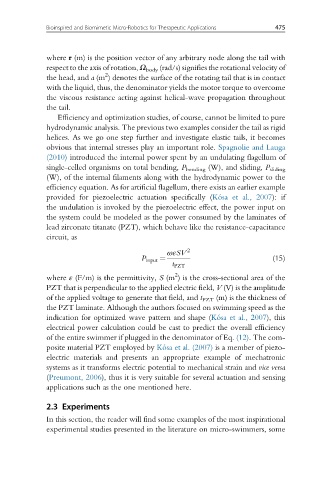Page 481 - Handbook of Biomechatronics
P. 481
Bioinspired and Biomimetic Micro-Robotics for Therapeutic Applications 475
where r (m) is the position vector of any arbitrary node along the tail with
respect to the axis of rotation, Ω body (rad/s) signifies the rotational velocity of
2
the head, and a (m ) denotes the surface of the rotating tail that is in contact
with the liquid, thus, the denominator yields the motor torque to overcome
the viscous resistance acting against helical-wave propagation throughout
the tail.
Efficiency and optimization studies, of course, cannot be limited to pure
hydrodynamic analysis. The previous two examples consider the tail as rigid
helices. As we go one step further and investigate elastic tails, it becomes
obvious that internal stresses play an important role. Spagnolie and Lauga
(2010) introduced the internal power spent by an undulating flagellum of
single-celled organisms on total bending, P bending (W), and sliding, P sliding
(W), of the internal filaments along with the hydrodynamic power to the
efficiency equation. As for artificial flagellum, there exists an earlier example
provided for piezoelectric actuation specifically (Ko ´sa et al., 2007): if
the undulation is invoked by the piezoelectric effect, the power input on
the system could be modeled as the power consumed by the laminates of
lead zirconate titanate (PZT), which behave like the resistance-capacitance
circuit, as
ωεSV 2
P input ¼ (15)
t PZT
2
where ε (F/m) is the permittivity, S (m ) is the cross-sectional area of the
PZT that is perpendicular to the applied electric field, V (V) is the amplitude
of the applied voltage to generate that field, and t PZT (m) is the thickness of
the PZT laminate. Although the authors focused on swimming speed as the
indication for optimized wave pattern and shape (Ko ´sa et al., 2007), this
electrical power calculation could be cast to predict the overall efficiency
of the entire swimmer if plugged in the denominator of Eq. (12). The com-
posite material PZT employed by Ko ´sa et al. (2007) is a member of piezo-
electric materials and presents an appropriate example of mechatronic
systems as it transforms electric potential to mechanical strain and vice versa
(Preumont, 2006), thus it is very suitable for several actuation and sensing
applications such as the one mentioned here.
2.3 Experiments
In this section, the reader will find some examples of the most inspirational
experimental studies presented in the literature on micro-swimmers, some

